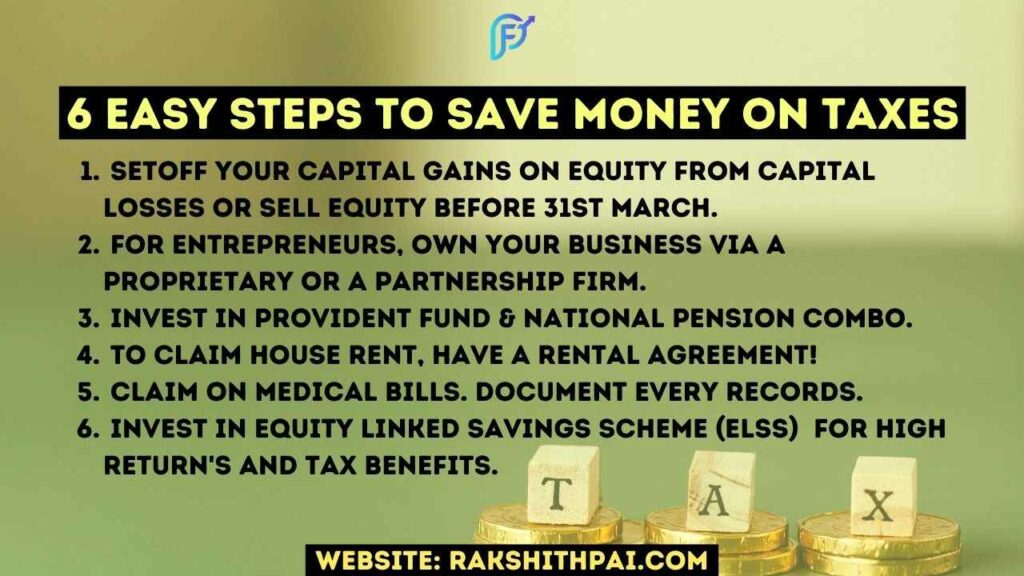Table of Contents
Introduction to Paying Tax:
When it comes to paying their income taxes, everyone is constantly looking for methods to save money. To avoid foregoing potential tax savings, no one wants to ignore potential avenues of action. Everyone has their own preferred method.
It’s not uncommon for people to rely only on tried-and-true strategies for minimizing their tax obligations, even when better alternatives exist. This post is written for taxpayers who wish to learn additional strategies for minimizing their tax obligations. Here are some ideas for business owners and salaried employees in India who want to pay less income tax.
In India, the individual tax filing period falls on July 31st of the following year. Meaning, for this FY 2022–23, you are supposed to pay tax by July 31st, 2023 if there’s no extension of time.
15 Best Ways to Save Income Tax in India:
But, when it comes to tax planning, you are supposed to make all the required arrangements by the end of January at the latest. And, hand over all the required details to your chartered accountant at least by the first week of July. Or any month the tax department sets the due date. Let’s not overburden our CAs by giving them the details at the very end. Remember, they do have other work too.
Top Tax Planning steps Indian Individuals must know to Save Tax:

Capital Gains on Equity
Before March 31, 2018, long-term capital gains from the sale of shares or the redemption of units were free from taxation.
After an amendment, as per the act, your gains over and above Rs. 1,00,000 will be charged for capital gains tax. So, in order to avoid paying taxes, just check if you have any long-term capital losses.
If you do, you can set off the loss with your gains. For this, simply sell your stocks or mutual funds on which you get LTCG tax before March 31st of the year.
People who don’t plan to sell their shares soon could use “The Rolling Concept” to reduce their tax bill when they do sell in the future.
For example, suppose you put Rs 10 lakhs into stock on May 26, 2014 (these shares will become Long Term Capital Assets on May 26, 2015). You’d like to reduce your taxable gain by holding these shares for a longer period of time. If you sell your shares after March 31, 2018, they will be considered a long-term asset and subject to capital gains tax at a rate of 10% on the amount by which the LTCG exceeds Rs 1 lakh.
Long-term capital gains achieved before January 31, 2018, however, will remain unaffected. Gains incurred after that time will not be subject to taxation. Note that the 31st January 2018 FMV will be used to calculate capital gains if the value of the investments is higher than their original purchase price.
HUF, proprietary, or even a partnership firm
As far as tax is concerned, try to represent yourself via a HUF, proprietary, or even a partnership firm. I can give my own example. Basically, I earn in dollars. The income I get will be converted to Indian rupees, as in the case of foreign remittance.
Anyhow, if I had chosen to file tax on my own in my name as an individual, on a rough calculation, I’d be asked to pay at least 15 to 20% tax.
But, since I’m going through my GST registered proprietary, under the composition scheme, I can pay tax at just 6%. Trust me, it makes a lot of difference for entrepreneurs to be not you when in case of filing taxes.
Unfortunately, salaried employees can’t do much in this regard. I mean, you have no other option but to earn it all on your own. For more information, please contact your CA.
NPS & PF Combo
National Pension Scheme
The government of India has instituted the National Pension System (NPS) to ensure that all subscribers get a steady stream of funds once they reach retirement age. The NPS is overseen by PFRDA (the Pension Fund Regulatory and Development Authority).
Salaried Individual:
In India, under Section 80CCD (1B), you can deduct up to Rs. 50,000 from your taxable income. This perk is in addition to the Rs. 1,50,000 tax break cap that can be claimed.
Up to 10% of your pay before dearness allowance can be invested tax-free under Section 80CCD (1). Section 80C of the Income Tax Act of 1961 caps this deduction at Rs. 1,50,000.
Self Employed:
Section 80CCD (1B) allows a tax break of up to Rs. 50,000. It exceeds the Rs. 1,50,000 cap imposed by section 80C on tax benefits.
Investing up to 20% of your yearly gross income allows you to deduct such contributions from your taxable income under Internal Revenue Code Section 80CCD (1). Section 80C of the Income Tax Act of 1961 caps the value of this tax break at Rs. 1,500,000.
National Pension Scheme – Its Advantages & Disadvantages, Types, and Features Explained:
Public Provident Fund
Every year, you can get a tax break for putting money into your PPF according to Section 80C of the Income Tax Act. Anyone is entitled to deductions up to the set maximum. Previously, PPF contributions were only tax deductible up to Rs. 1 lakh; this has been raised to Rs. 1.5 lakh for the next fiscal year, 2019–20.
Each year, you can put up to Rs. 1.5 lakhs into your PPF account and all of those contributions are tax deductible under section 80C. A total of Rs. 1.5 lakhs per year, across all investment vehicles, can be deducted in accordance with Section 80C.
Another perk of PPF accounts is their tax advantages. There is no wealth tax on PPF accounts or proceeds and no income tax on any interest generated on PPF deposits. You may avoid paying taxes on your deposits, your earnings, and your wealth all at once with a PPF account.
To Conclude, just know that your contribution to NPS and PF is tax deductible up to Rs. 1,50,000 under section 80C. And an additional 50k under 80CCD (1B).
Should You Invest In EPF?
House Rent Allowance (HRA)
The term “Rent Allowance” refers to money a company gives an employee to cover the cost of living near their workplace.
Despite the fact that a deduction for HRA is permitted under Section 10(13A) of the Income Tax Act, house rent allowance (HRA) may be entirely or partially taxable.
Salary, HRA received, actual rent paid, and location of work and home all play a role in determining the HRA deduction amount. The tax breaks associated with HRAs are available to those who are self-employed as well.
If you are living in a rented house, don’t forget to make a rental agreement. With the agreement, you can claim House Rent Allowance. And, if you do not receive any HRA, you can claim a deduction under section 80GG. Watch this video to know more. CLICK HERE!
Medical Bills
Health insurance premiums plus the cost of an annual physical can be written off as a deduction under Section 80D of Chapter VI (A) Income Tax act.
Section 80D allows for a reduction in taxable income for qualifying individuals and Hindu Undivided Families (HUFs). Tax breaks are available for those who pay for their own health insurance as well as that of their spouse, dependent children, and parents. Section 80D of the Income Tax Act of 1961 qualifies this, with certain caveats.
If you are less than 60 years old, you can deduct up to Rs. 25,000 under Section 80D. The ‘25,000 cap includes the ‘5,000 allotted for preventive health checkups and screenings. If the covered person is 60 years or older, the deduction cap rises to Rs. 50,000.
To conclude Section 80D, your medical insurance covers up to Rs.25,000 for you, your spouse, and your children, and up to Rs.50,000 for senior citizen parents. Remember, claiming insurance is a bit of a hassle.
So, don’t leave any chance here. Keep records of all the medical bills. Document everything. For more information on 80D, CLICK HERE!
Equity Linked Savings Scheme (ELSS)
The advantages of investing in ELSS mutual funds are two-fold: immediate tax savings and long-term capital appreciation. The lock-in period for ELSS mutual funds is only three years, which is the shortest of all tax-saving investments. They also have the potential to give the best returns among 80C investments.
Under Section 80C of the Income Tax Act, 1961, investors in equity-linked savings products (ELSS) mutual funds are eligible for annual tax deductions of up to Rs 1,50,000. This can save you up to Rs 46,800 in taxes per year. However, remember that from the date of investment until the third year from that date, your money will be unavailable for withdrawal.
The Equity Linked Savings Scheme is the only mutual fund variant that allows you to claim a tax deduction if you invest in equity and related products. With ELSS, you can earn better returns with moderate risk.
Here, the investments are tax deductible under section 80C up to Rs. 1,50,000. If you have an annual income of over 10 lakh, please consider investing in ELSS. I’ve written a detailed article on the topic; CLICK HERE!
For More Information, Check this Video:
Coming up…
Disclaimer: All the information on this website is published in good faith and for general information purposes only.









